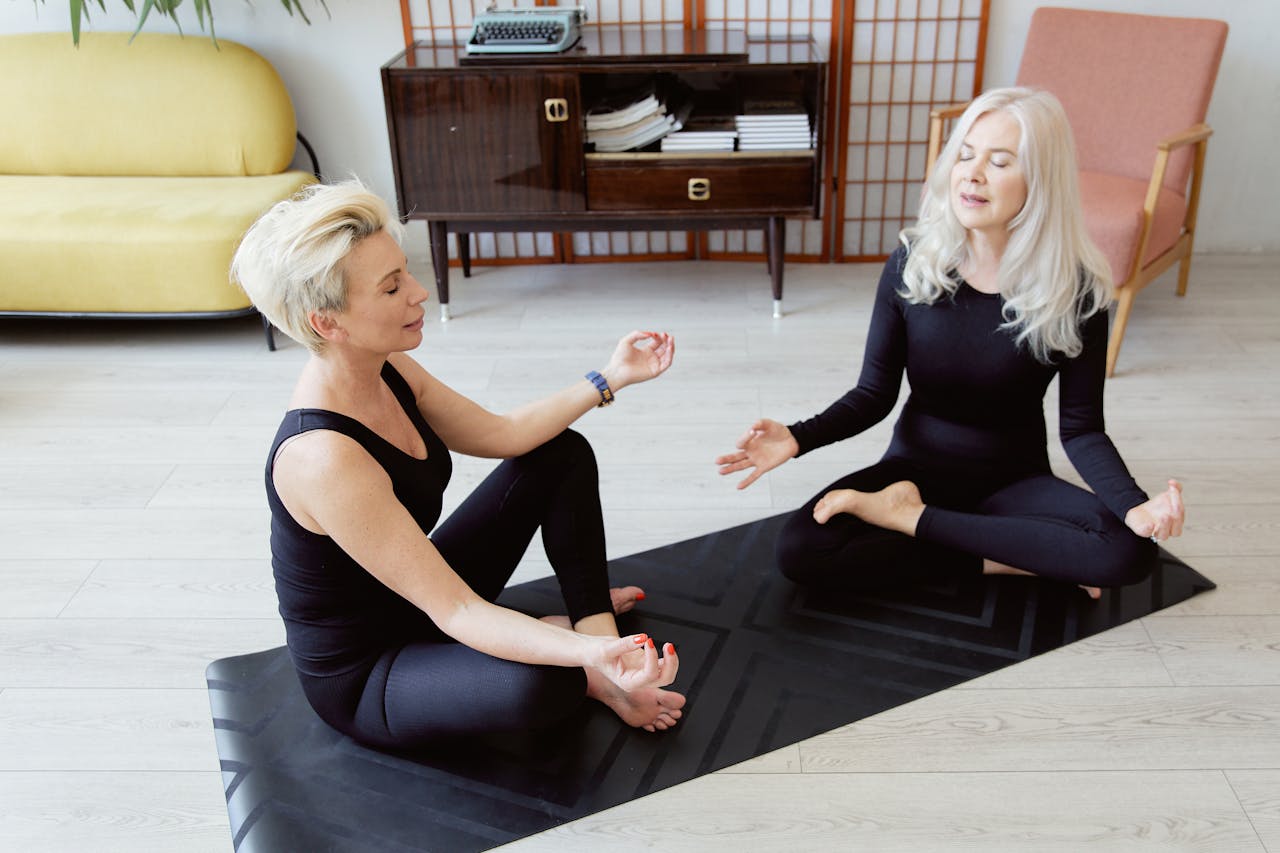
Table of Contents
Unlock your inner calm and reduce stress with mindful breathing exercises. Explore these simple yet effective techniques to reduce anxiety, improve mental clarity, and get better sleep.
What Is Mindful Breathing?
At its core, mindfulness breathing directs focus to one’s breath, typically during meditation practice.
Mindful breathing provides an effective technique to strengthen the mind-body connection. The strength of mindful breathing lies in its versatility and accessibility, as one can practice it anywhere and at any time.
Many mindful breathing exercises center on bringing one’s focus to the paying deliberate attention to the breath, regulating its rhythm, and incorporating deep breathing and intentional breathing patterns.
There are no rigid rules governing these exercises, and while guided meditationcourses can be helpful, the true strength of mindful breathing comes from regular practice.
Benefits of Mindful Breathing
Mindful breathing exercises are powerful tools for improving health and well-being. There are many benefits from regular mindful breathing, including:
- Improved anxiety management
- Improved sleep
- Pain management
- Decreased blood pressure
- Improved emotional regulation
Stress Management
Mindful breathing alleviates stress by activating the relaxation response, which reduces stress hormones, lowers heart rate, and calms the nervous system.
Mindful breathing enhances self-awareness, helping individuals recognize and accept their emotions and sensations without judgment.
Mindful breathing can also help interrupt the rumination cycle and empower better emotional regulation.
Additionally, mindful breathing sharpens concentration, aiding in decision-making and task performance.
Sleep
Mindful breathing aids sleep by calming the mind and body, redirecting thoughts from worries, and triggering the relaxation response.
Participating in slow and rhythmic breathing patterns helps to reduce anxietyand calm the mind.
Engaging in mindful breathing before sleep can help one establish a better bedtime routine for more restful sleep and improved daytime functioning.
Emotional Regulation
Mindful breathing is a valuable tool for emotional regulation as it creates a natural pause before one responds to stressful situations. This allows one to observe and manage their emotions more clearly.
Focusing on one’s breath can help to disengage from intense emotional reactions, fostering a more balanced and intentional response to challenging situations.
Mindful breathing can also help manage negative emotions by allowing someone to respond to challenging situations less impulsively and providing an opportunity to reflect on negative emotions.
Physical Health
Mindful breathing offers a range of physical health benefits. Firstly, it reduces stress, and chronic stress can have a detrimental impact on the body.
By reducing stress, one is lowering the risk of stress-related illnesses such as heart disease and hypertension.
Mindful breathing reduces stress hormones and supports a healthy cardiovascular system.
Additionally, mindful breathing improves lung function and oxygenates the body more efficiently, potentially improving overall respiratory health.
How Mindful Breathing Works
Mindful breathing exercises reduce stress, lower heart rate, and decrease stress hormone production by activating the parasympathetic nervous system.
The parasympathetic nervous system is a part of the autonomic system that controls the relaxation response and counteracts the fight or flight response in the body. By activating this system, the body naturally returns to a state of calm and rest.
Mindful breathing also enhances cognitive functions, enhancing concentration and emotional regulation by focusing attention on the breath and the present moment without judgment.
Types of Mindful Breathing Techniques
Many mindful breathing techniques exist, each offering their own approach to mindfulness through breathwork.
Mindful breathing techniques focus on paying attention to one's breath, controlling one's breathing rate, and often concentrating on deep breathing.
Basic Mindful Breathing
This basic method of mindful breathing involves paying close attention to one's natural breath and developing breath awareness.
To perform mindful breathing, one needs to simply observe the sensation of their breath as it goes in and out of their nose or mouth.
This simple practice helps to develop breath awareness, center themselves in the present moment, and cultivate mindfulness.
Counting Breaths
In this technique, one counts each breath cycle. One would perform counting breaths by inhaling and exhaling quietly while mentally counting the length of each breath.
This practice helps to gently bring focus to own breathing pattern and help one to begin regulating one's breathing.
Box Breathing or Square Breathing
Box breathing is a mindful breathing technique that uses the imagery of a box to control and regulate breathing rate.
Box breathing involves inhaling for a count of four, holding for a count of four, and exhaling for a count of four.
People typically use box breathing for relaxation and stress reduction. Box breathing can also help one practice deep breathing, which has positive effects on both the mind and body.
4-7-8 Breathing
The 4-7-8 breathing technique is a mindful breathing exercise that slows the breathing rate and facilitates the relaxation response.
In this technique, individuals inhale for a count of 4, hold their breath for a count of 7, and exhale slowly for a count of 8.
Alternate Nostril Breathing (Nadi Shodhana)
This yogic breathing technique involves closing one nostril at a time while inhaling and exhaling through the other.
Alternate Nostril Breathing balances the body's energy and calms the mind.
Diaphragmatic Breathing
Diaphragmatic breathing, also known as belly breathing, involves the deep inhalation and exhalation of air by engaging the diaphragm muscle, which can promote relaxation and reduce stress.
To perform diaphragm breathing one breaths deeply with their hands resting on their belly so that they can feel the rise and fall of the belly which each breath.
Mindfulness Meditation
Mindful breathing is a fundamental component of meditation practices.
An essential element of mindfulness meditation is directing one’s attention to the natural rhythm of one's breath.
Mindfulness meditation practices foster heightened awareness, reduce stress, and foster inner tranquility and clarity.
Loving Kindness Meditation (Metta Bhavana)
Loving Kindness Meditation, or Metta Bhavana, involves silently repeating phrases like “May I be happy, may I be healthy,” and gradually extending these wishes to others.
This practice fosters compassion, reduces negative emotions, builds greater resilience to stress and enhances emotional well-being, promoting inner peace and empathy.
Mindful Breathing and Yoga
During yoga sessions, practitioners align their breath with movement, coordinating each pose with intentional inhalations and exhalations.
This connection between breath and motion enhances the mind-body relationship and promotes relaxation and balance.
How to Breathe Mindfully
To perform mindful breathing it is important to find a quiet and peaceful space, where one can sit or lie down comfortably and close their eyes if they prefer.
The primary goal of mindful breathing is to focus on the breath, observing its natural rhythm without judgment.
To breathe mindfully, begin to Inhale and exhale gently, noticing the sensation of each breath. When the mind wanders, gently redirect the focus back to the breath.
This simple mindful breathing practice cultivates present-moment awareness, reduces stress, and enhance overall well-being.
Who Should Practice Mindful Breathing?
Mindful breathing exercises have the potential to help everyone.
That said, it is incredibly beneficial for those who are frequently stressed, anxious, or overwhelmed.
Incorporating mindful breathing meditation into one’s daily routine can be valuable for coping with stress and anxiety.
Where to Learn About Mindful Breathing
To learn about mindful breathing, there are many resources readily available. Here are a few:
- Online meditation and mindfulness streaming platforms
- Websites and blogs dedicated to mindfulness exercises like Anahana
- Mobile apps designed for breathwork
When to Practice Mindful Breathing
Morning Routine
Combining mindful breathing into one's morning routine is beneficial to start the day with a sense of calm, reduce early-morning stress or anxiety, enhance focus and productivity, and establish a positive mindset for the rest of the day.
Stressful Moments
One can use mindful breathing to prepare for stressful situations. Focusing on one's breath can help to calm the mind and the body to prepare oneself for stressful moments.
Before Sleep
Incorporate mindful breathing into your bedtime routine to relax the mind and improve sleep quality.
Mindful Breathing: Frequently Asked Questions
What Does it Mean to be Mindful?
Being mindful is a state of mind where your full attention is on the present moment, allowing you to engage more fully with your experiences and surroundings.
This state of mind can be cultivated through mindfulness breathing meditation, progressive muscle relaxation, yoga, tai chi, and even during everyday activities like walking or eating, helping you foster a deeper sense of presence and awareness in your life.
Can I Combine Mindful Breathing with Other Techniques?
Mindful breathing is a technique one can incorporate into many other practices, such as meditation practice, progressive muscle relaxation, yoga, tai chi, and daily activities like walking or eating.
How Should I Practice Mindful Breathing?
The decision and commitment to mindful breathing rest entirely with you, depending on the time you will allocate for this practice.
Even a few minutes during work breaks or in between tasks can be valuable. When you return home, consider dedicating five to seven minutes to this exercise, ensuring you are comfortably positioned.
The benefits of mindful breathing come from practicing this technique regularly. Try to practice mindful breathing at least a couple of times a week to make it a regular practice in your life.
References
Relaxation Response: Dr. Herbert Benson Teaches You The Basics
The Effectiveness of Daily Mindful Breathing Practices on Test Anxiety of Students - PMC
Disclaimer
The contents of this article are provided for informational purposes only and are not intended to substitute for professional medical advice, diagnosis, or treatment. It is always recommended to consult with a qualified healthcare provider before making any health-related changes or if you have any questions or concerns about your health. Anahana is not liable for any errors, omissions, or consequences that may occur from using the information provided.

By: Clint Johnson
Clint is the driving force and founder of Anahana. Clint teaches Yoga, Pilates, mindful breathing, and meditation, catering to a global community of students and teachers.
